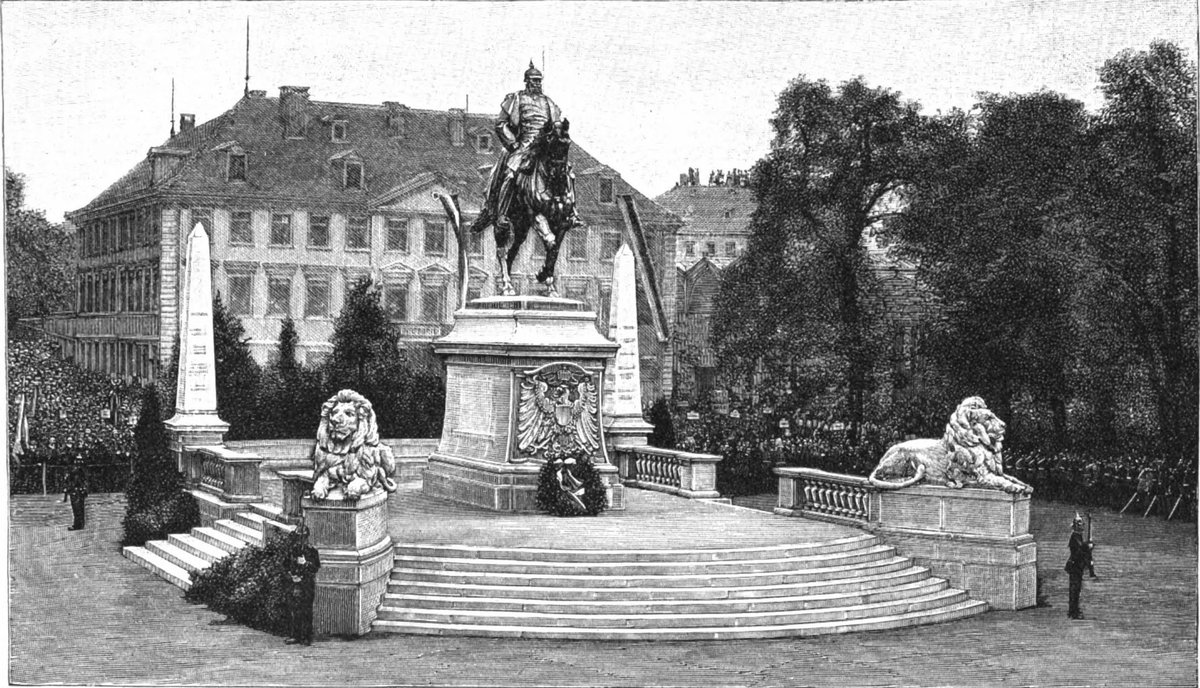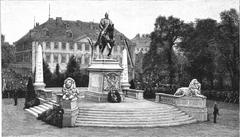
Kaiser Wilhelm Denkmal Stuttgart: Visiting Hours, Tickets, and Comprehensive Guide
Date: 14/06/2025
Introduction
Rising gracefully in the heart of Stuttgart’s historic Karlsplatz, the Kaiser-Wilhelm-Denkmal stands as an enduring symbol of German unification and imperial heritage. Unveiled in 1898, this striking equestrian statue commemorates Kaiser Wilhelm I, the first German Emperor and King of Prussia. Conceived during a period of national transformation, the monument represents both Württemberg’s loyalty to the German Empire and the city’s place within a changing Germany.
Today, the Kaiser-Wilhelm-Denkmal is not only a treasured historical landmark but also a dynamic part of Stuttgart’s cityscape—accessible to all visitors, surrounded by architectural icons, and integral to local cultural life. This guide provides a detailed overview of the monument’s history, visitor information, accessibility, and tips to help you make the most of your visit.
For more background, see the official Stuttgart Tourism website (Stuttgart Tourism) and in-depth historical analysis from Kontext Wochenzeitung.
Historical Context and Significance
Origins and Motivation
Commissioned following Kaiser Wilhelm I’s death in 1888, the monument was intended to honor his leadership during the Franco-Prussian War and pivotal role in unifying Germany. A committee, spearheaded by Prince Wilhelm of Württemberg, led community fundraising and planning for a monument that would reflect Württemberg’s connection to the new empire.
Design and Symbolism
Wilhelm von Rümann, a renowned sculptor, and architect Friedrich Ritter von Thiersch, were chosen through a design competition. Their vision realized a dignified bronze equestrian statue atop a granite pedestal, framed by symbolic granite lions and obelisks. The Emperor’s composed, authoritative pose atop his striding horse embodies unity and strength, while the surrounding lions and obelisks reference vigilance and victorious nationhood.
Inauguration and Public Reception
The monument was unveiled on October 1, 1898, in a grand public ceremony attended by royalty and citizens alike. Its design was praised for balancing imperial grandeur with artistic restraint, and for highlighting Wilhelm I’s virtues without excess.
National and Regional Identity
The Kaiser-Wilhelm-Denkmal was part of a nationwide movement to commemorate German unification. Its location in Stuttgart, a city with a history of regional independence, underscores the nuanced relationship between local identity and imperial loyalty.
Preservation and Contemporary Relevance
Unlike many imperial monuments, the Kaiser-Wilhelm-Denkmal survived the turbulence of the 20th century. It remains a focal point for reflection on memory, identity, and the complexities of Germany’s past. Contemporary debates occasionally arise about its meaning and role, particularly in light of evolving perspectives on monuments and history (Kontext Wochenzeitung).
Visitor Information: Hours, Tickets, and Accessibility
Location
The monument occupies the center of Karlsplatz, a prominent square framed by significant landmarks—Altes Schloss (Old Castle) to the north, Neues Schloss (New Palace) to the east, the Dorotheen Quartier to the west, and the Charlottenplatz wing of the Old Orphanage to the south. The square’s design, enclosed by chestnut trees, provides a tranquil, shaded environment (Wikipedia: Karlsplatz (Stuttgart)).
Opening Hours
The Kaiser-Wilhelm-Denkmal and Karlsplatz are open to the public 24 hours a day, year-round. As an outdoor monument, there are no specific opening or closing times.
Tickets
No tickets or entrance fees are required to access the monument or Karlsplatz.
Accessibility
- Wheelchair and limited mobility access is available via level pathways and ramps.
- Public transportation (U-Bahn stations Schlossplatz and Staatsgalerie) offers easy access, with facilities for mobility-impaired visitors.
Facilities
While the monument itself does not have dedicated facilities, Karlsplatz is surrounded by cafés, restaurants, shops, and restrooms within the nearby Dorotheen Quartier and city center.
Experience and Atmosphere
Karlsplatz, though centrally located, remains less crowded than nearby Schlossplatz, offering a calm atmosphere beneath mature chestnut trees. Whether you are on a city stroll, a guided tour, or simply seeking a quiet spot to reflect, the monument’s setting invites exploration.
- Best Time to Visit: Early mornings and late afternoons (golden hours) are perfect for photography and peaceful reflection.
- Events: The square regularly hosts flea markets, festivals, and public gatherings, infusing energy and local flavor into the area.
Guided Tours, Audio Guides, and Special Events
- Guided Tours: Local operators and the Stuttgart tourism office include the monument in historical walking tours. Check current offerings at the Stuttgart Tourism website.
- Audio Guides: Enhance your visit with the Audiala app, which provides expert audio commentary and immersive storytelling about the monument and its context (Audiala: Audio Guide App for Stuttgart).
- Events: Karlsplatz frequently hosts cultural and seasonal events. Consult local event calendars to align your visit with these occasions.
Nearby Attractions
Combine your visit to the Kaiser-Wilhelm-Denkmal with other top Stuttgart sites:
- Neues Schloss: Baroque palace on Schlossplatz.
- Altes Schloss: Renaissance-era castle housing the Württemberg State Museum.
- Markthalle Stuttgart: Historic market hall with culinary delights.
- Staatsgalerie: Renowned art museum.
- Wilhelma: Zoological and botanical garden.
All are within easy walking distance, making Karlsplatz an ideal starting point for exploring Stuttgart’s cultural and historical highlights.
Monument Design and Artistic Features
- Stepped Granite Base and Pedestal: Elevates the monument, adorned with reliefs and inscriptions referencing unity and military triumph.
- Bronze Equestrian Statue: Wilhelm I depicted in military regalia, exemplifying late 19th-century craftsmanship.
- Symbolic Elements: Granite lions and obelisks reinforce themes of power, vigilance, and victory.
- Urban Orientation: The statue’s placement and direction connect visually to the Neues Schloss, reinforcing Württemberg’s imperial ties.
For additional details on the monument’s design, see Komoot: Karlsplatz mit Standbild Kaiser Wilhelm.
Cultural and Political Context
Imperial Symbolism and Local Identity
The monument embodies both the pride of German unification and the specific regional context of Württemberg, which balanced participation in the German Empire with its own traditions and autonomy.
Changing Attitudes
Over time, public perception has shifted. Once a symbol of imperial authority, the monument is now a focal point for discussions about history, memory, and the representation of the past in public spaces (Kontext Wochenzeitung).
Broader Historical Connections
The Kaiser-Wilhelm-Denkmal is just one of many such monuments across Germany, each reflecting the era’s complex interplay of nationalism, monarchy, and evolving political landscapes (History Tools; Glimpses of History; Ciplav.com).
Practical Tips for Visitors
- Combine Your Visit: Plan to see other nearby attractions for a rich, half- or full-day itinerary.
- Photography: The monument is most photogenic during early morning or late afternoon, especially with the chestnut trees in full leaf.
- Family-Friendly: The open square and outdoor setting are suitable for children and families.
- Cyclists and Walkers: Karlsplatz is a waypoint for several urban walking and cycling routes.
- Markets and Festivals: Visit during market days or festivals for a lively cultural experience.
Frequently Asked Questions (FAQ)
Q: What are the visiting hours for Kaiser-Wilhelm-Denkmal?
A: The monument and Karlsplatz are open 24/7 as an outdoor public space.
Q: Is there an entrance fee or are tickets required?
A: No, the monument is freely accessible at any time.
Q: Are guided tours available?
A: Yes, several local tour operators and the Stuttgart tourism office offer guided tours that include the monument.
Q: Is the monument accessible for wheelchair users?
A: Yes, the square and monument feature level paths and ramps for easy access.
Q: What is the best time of year to visit?
A: The warmer months are ideal, particularly during market events or festivals.
Q: Where can I find more information or audio guides?
A: Use the Audiala app or consult the Stuttgart Tourism website.
Visuals and Media
Include high-resolution images of:
- The Kaiser-Wilhelm-Denkmal from multiple angles
- Close-ups of the equestrian statue, lions, and obelisks
- Karlsplatz’s shaded walkways and surrounding architecture
- Maps indicating monument location
Recommended alt tags: “Kaiser-Wilhelm-Denkmal Stuttgart equestrian statue”, “Karlsplatz chestnut trees and monument”, “Kaiser-Wilhelm-Denkmal tickets”, “Kaiser-Wilhelm-Denkmal visiting hours”.
Further Resources
For additional information and planning:
- Stuttgart Tourism Official Website
- Kaiser-Wilhelm-Denkmal Information on Stuttgart City Site
- Audiala: Audio Guide App for Stuttgart
- Kontext Wochenzeitung Article on the Monument
- Komoot: Karlsplatz mit Standbild Kaiser Wilhelm
- Wikipedia: Karlsplatz (Stuttgart)
- History Tools: Kaiser Wilhelm II
- Glimpses of History: Kaiser Wilhelm II and Weltpolitik
- Ciplav: The Kaiser’s Abdication and Germany
Summary and Call to Action
The Kaiser-Wilhelm-Denkmal in Stuttgart offers visitors an immersive journey into Germany’s imperial history and Württemberg’s unique role in that era. Its central location, free year-round access, and proximity to other major attractions make it an essential stop for any traveler seeking to understand Stuttgart’s heritage.
Whether you are exploring on your own, joining a guided tour, or using the Audiala app for expert audio commentary, the monument provides a rich context for reflection on the past and its relevance today. Combine your visit with local markets, festivals, and culinary experiences for a memorable day in Stuttgart’s vibrant city center.
Plan your visit today—download the Audiala app for up-to-date guides, and follow Stuttgart’s cultural channels for the latest events and visitor information. The Kaiser-Wilhelm-Denkmal awaits as a living gateway to the stories that have shaped Germany.




















































